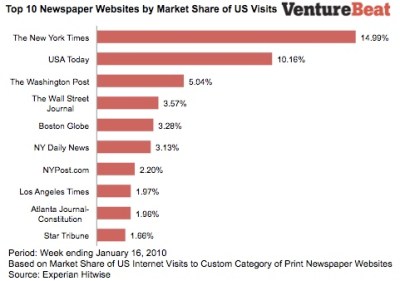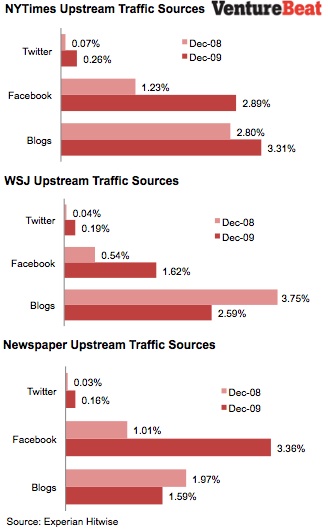The New York Times just announced that it will begin charging frequent visitors a flat fee for full access to the site in early 2011. Non-paying visitors will be allowed to view a certain number of articles per month.
The New York Times is the leading print newspaper website according to Experian Hitwise, and accounted for nearly 15% of visits to all newspaper sites for the week ending January 16, 2010. But visits have been declining — Experian Hitwise data showed a year over year market share decline of 20% compared to a category average decline of 12%.
A paywall will surely alienate many users, and one blogger already likened the paywall plan to a suicide attempt. Social media — Twitter, Facebook, and blogs — is an increasing source of traffic for newspaper sites as well as all news websites. But will social media users be as willing to post links on Facebook, Twitter, and blogs when they are not sure if their followers can access the link?
AI Weekly
The must-read newsletter for AI and Big Data industry written by Khari Johnson, Kyle Wiggers, and Seth Colaner.
Included with VentureBeat Insider and VentureBeat VIP memberships.
The Wall Street Journal is currently the only major US newspaper that charges for access. Following is a comparative analysis of data from Experian Hitwise that shows how much traffic WSJ.com, NYTimes.com and other newspaper websites in general get from Twitter, Facebook and blogs.
- NYTimes.com received nearly 3% of its traffic from Facebook in December 2009, compared to only 1.6% for WSJ.com
- NYTimes.com recieved3.3% of its traffic from Blogs in December 2009, more than double the average for newspaper sites, which got 1.6% of traffic from blogs.
- WSJ.com and the Newspaper category overall lagged behind NYTimes.com in share of traffic from Twitter. While only 0.26% of NYTimes.com visits came from Twitter in December 2009, that number has nearly quadrupled in the past year.
Clearly, NYTimes.com is one of the most link-worthy newspaper sites. WSJ.com is not linked to nearly as much, which could be because of the paywall, smaller readership and an older audience potentially less likely to use social media. Both WSJ.com and NYTimes.com are actively encouraging the viral spread of articles by providing links for sharing on Facebook, Twitter, Digg, etc.
It seems underhanded for any online news site to encourage social media sharing, but not allow everyone to read the articles. Even though the total share of upstream traffic from Twitter, Facebook and blogs for NYTimes.com was still small, 6.46% of readers in December 2009, that equals nearly a million readers, and a lot of advertising revenue. Perhaps The New York Times is counting on that subscription revenue to more than make up for lost users and blogger ill-will. With nearly a year until the paywall is due to go up, let’s hope they plan the move carefully and get it right.
VentureBeat's mission is to be a digital town square for technical decision-makers to gain knowledge about transformative enterprise technology and transact. Learn More

